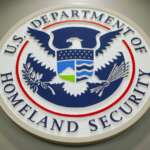WASHINGTON – Disney has long stoked a symbiotic relationship between its movies and theme parks. Usually, the films inspire the attractions, from Cinderella’s castle to Dumbo’s flying ride, but occasionally it’s the inverse, from “Pirates of the Caribbean” to “The Haunted Mansion” (2003).
Now, Disney is taking it a step further: adapting an entire section of Disneyland into the new movie “Tomorrowland.” The results are mixed but the hearts of the filmmakers — director Brad Bird (“Ratatouille”) and writer David Lindelof (“Lost”) — are firmly in the right place.
The film opens at the 1964 World’s Fair, where boy genius Frank Walker (Thomas Robinson) meets a tech wizard named Nix (Hugh Laurie) and a mysterious little girl named Athena (Raffey Cassidy). She gives him a “T” pin, which unlocks a secret portal into the future, found inside the prototype for “It’s a Small World” (Note to Disney diehards: Space Mountain hadn’t been invented yet).
Flash forward several decades, where teenager Casey Newton (Britt Robertson) is raised an optimist by her NASA father (Tim McGraw). He tells a fable of two wolves fighting, one an optimist and one a pessimist. Which one wins? The one you feed. So it’s up to her to break the cynicism of grown-up Frank (George Clooney) to unlock the secrets of Tomorrowland and save the future of mankind.
While these grand ideas at times perplex us, the casting makes it a journey worth riding.
If you didn’t know Britt Robertson six months ago, you do now, thanks to a string of high-profile roles across Jennifer Aniston in “Cake” (2014), Scott Eastwood in “The Longest Ride” (2015) and now Clooney here. Her rising star plays well off Clooney, who just landed the Lifetime Achievement Award at last year’s Golden Globes (highlight packages already included “Tomorrowland”).
Still, it’s child actor Raffey Cassidy who steals the show as a twitchy robot. She routinely gets the last laugh, be it going into “shutdown mode” to avoid Robertson’s questions, or looking Clooney straight in the eye to say, “You’re just not funny.” Cassidy is a capable star-in-the-making, aided her by special effects that make her lips quiver and eyes blink with the sped-up rapidity of a computer glitch.
It’s in these small moments where the special effects shine. To Bird’s credit, he directs the PG action with clever choreography, making it feel less like a CGI headache and more like carefully-executed storyboards. This elevates two battle scenes in particular, first inside an antique store — using merchandise of “Star Wars” and “The Day the Earth Stood Still” as weapons — then inside Clooney’s home with a series of sci-fi booby traps to repel robot invaders in “Home Alone” style.
Bird’s penchant for blocking — captured by Oscar-winning cinematographer Claudio Miranda (“Life of Pi”) — continues his growth from Pixar’s “The Incredibles” (2004) to live-action stunts like “Mission Impossible: Ghost Protocol” (2012). And yet, we still get the same child-like wonder that made his Pixar films a success, this time backed by co-writer Damon Lindelof, creator of TV’s “Lost.”
Just like “Lost,” the strongest stuff comes at the beginning, before spiraling into some real head-scratching. “Tomorrowland” runs off its own monorails in Act Three, becoming far too confusing for kids to follow. These mental loopty-loops are ambitious, no doubt, but even adults will have trouble once the plot reaches the Eiffel Tower, where animatronics of Thomas Edison, Gustave Eiffel, Nikola Tesla and Jules Verne leave us 20,000 leagues under comprehension.
This PG roller coaster may have benefited from a “must be this tall to ride” sign, but much of the film is so captivating and so imaginative that’s it’s well worth the ride. As soon as we enter the turnstiles of our multiplex, we’re hit with direct-address narration that’s comically interrupted by an off-screen voice, freezing the screen as the characters dispute how to tell the story. Before long, Bird convinces us that worlds are colliding, as past and present shift with the touch of Robertson’s “T” pin.
All the while, Bird is subversively rolling out a warning against the chief issue of our time: fear-mongering becoming a self-fulfilling prophecy of doom. In one pivotal montage, a string of school teachers paints an dystopian vision of George Orwell’s “1984” with enough “dark sarcasm in the classroom” to make Pink Floyd squirm.
Raising her hand, Robertson stands up: “I get that it’s bad. But what can we do to fix it?”
At this, the teacher stops in his tracks. He doesn’t have an answer. He hasn’t even thought about the answer. Rather, he has built an entire career on doom and gloom — without offering an alternative.
In this moment, “Tomorrowland” offers a great message for kids and a much-needed lesson for today’s adults, from politicians to cable news pundits. It’s easy to run campaigns against something — Democrats did it when George W. Bush was in office; Republicans are doing it now that Barack Obama is in office — but where are the positive alternatives? “Tomorrowland” isn’t perfect, but it’s a much needed dose of optimism. Who says Disney can’t do social commentary?
★ ★ 1/2
The above rating is based on a 4-star scale. See where this film ranks in Jason’s Fraley Film Guide. Follow WTOP Film Critic Jason Fraley on Twitter @JFrayWTOP.











